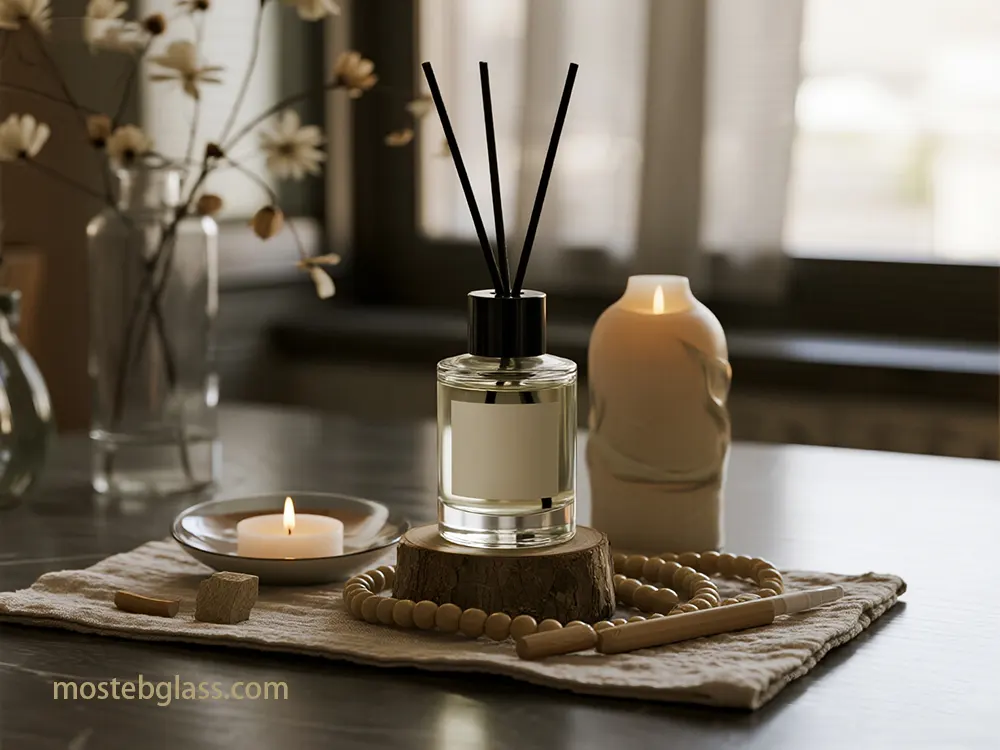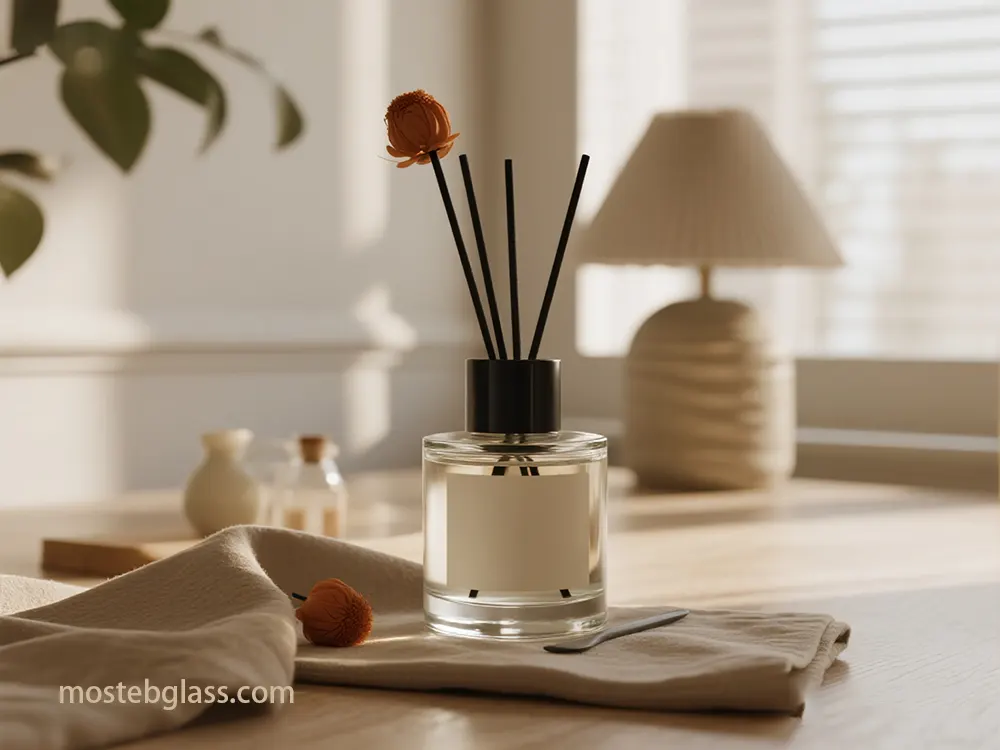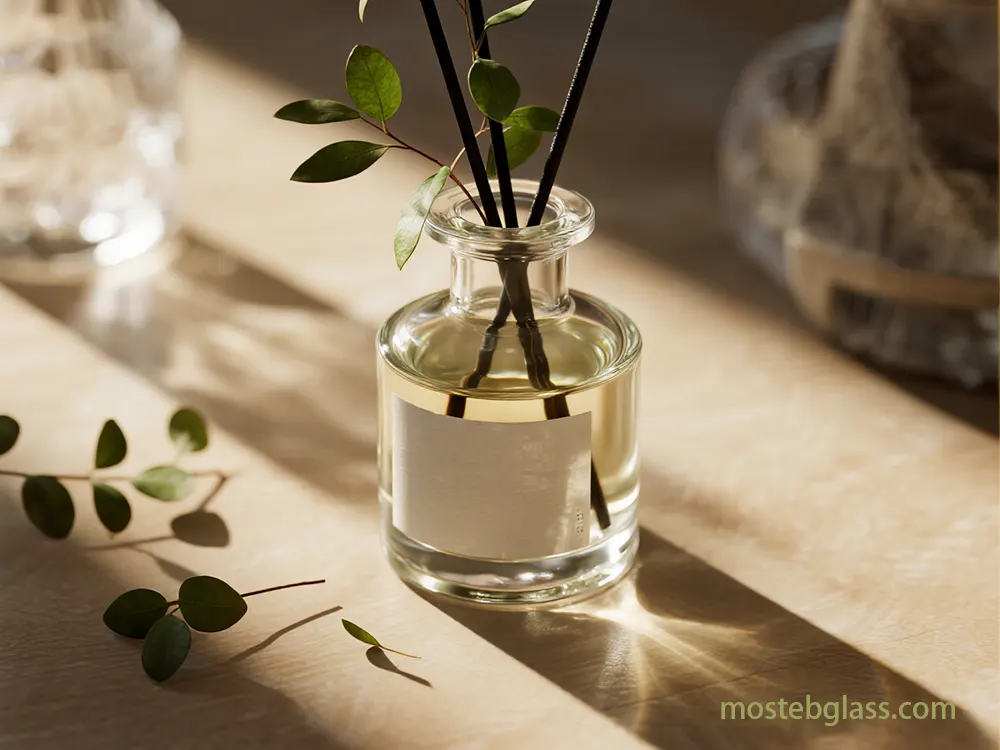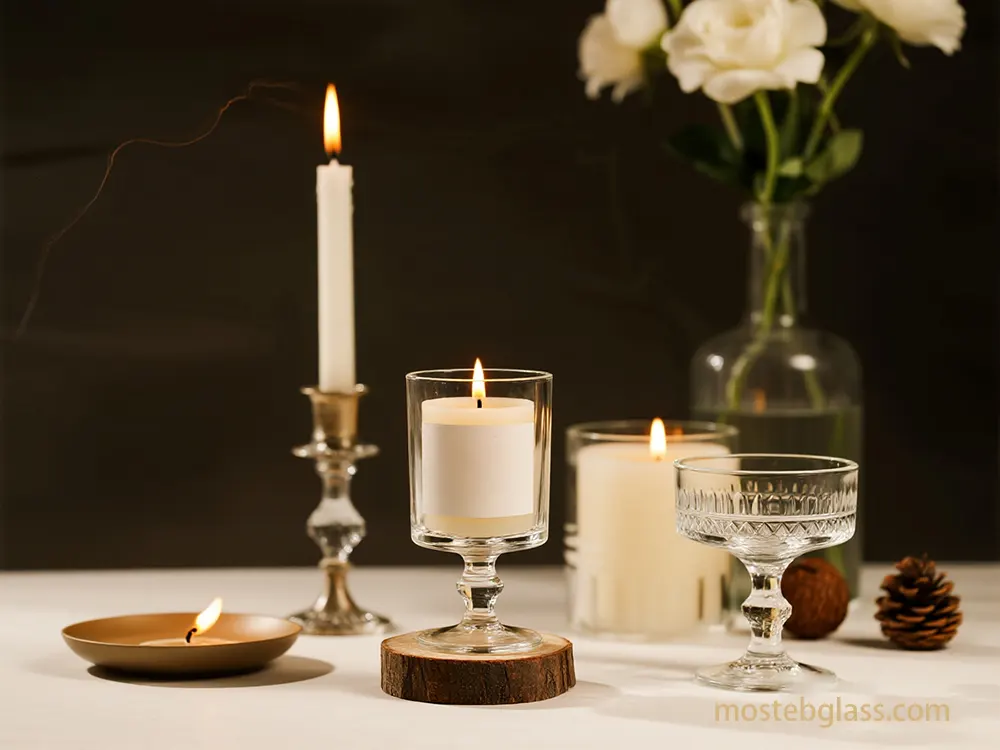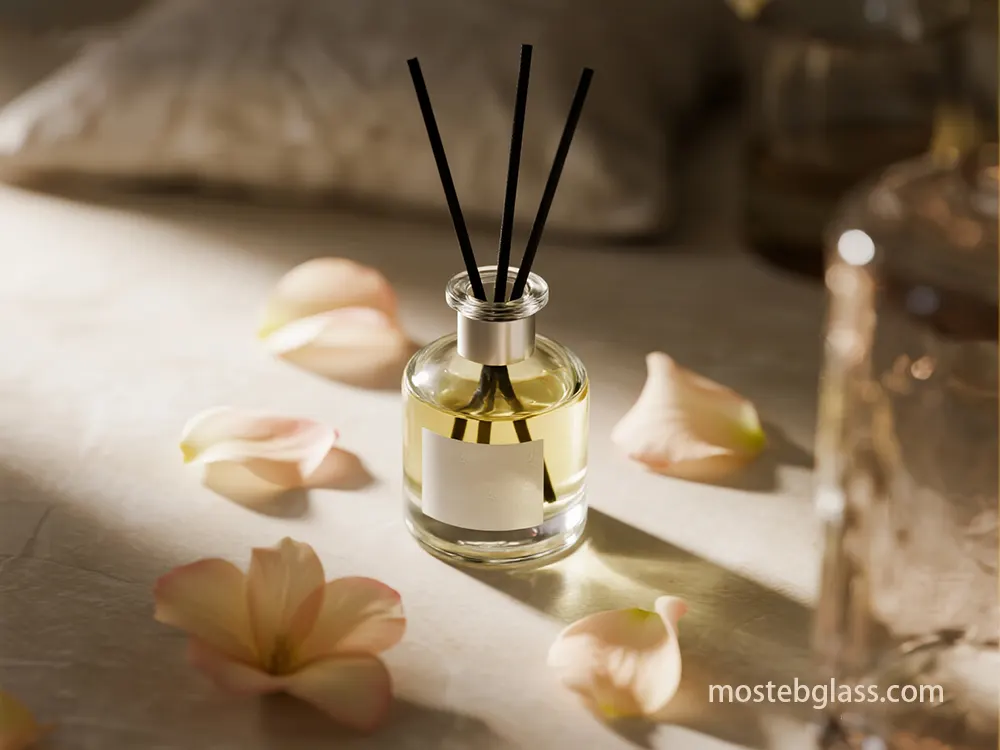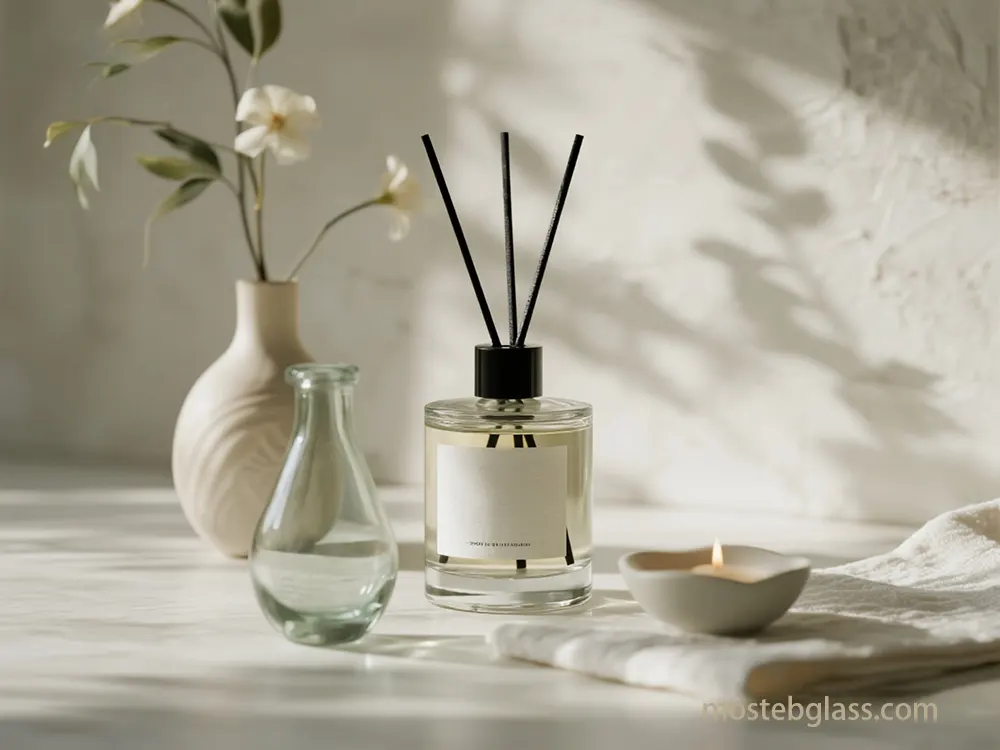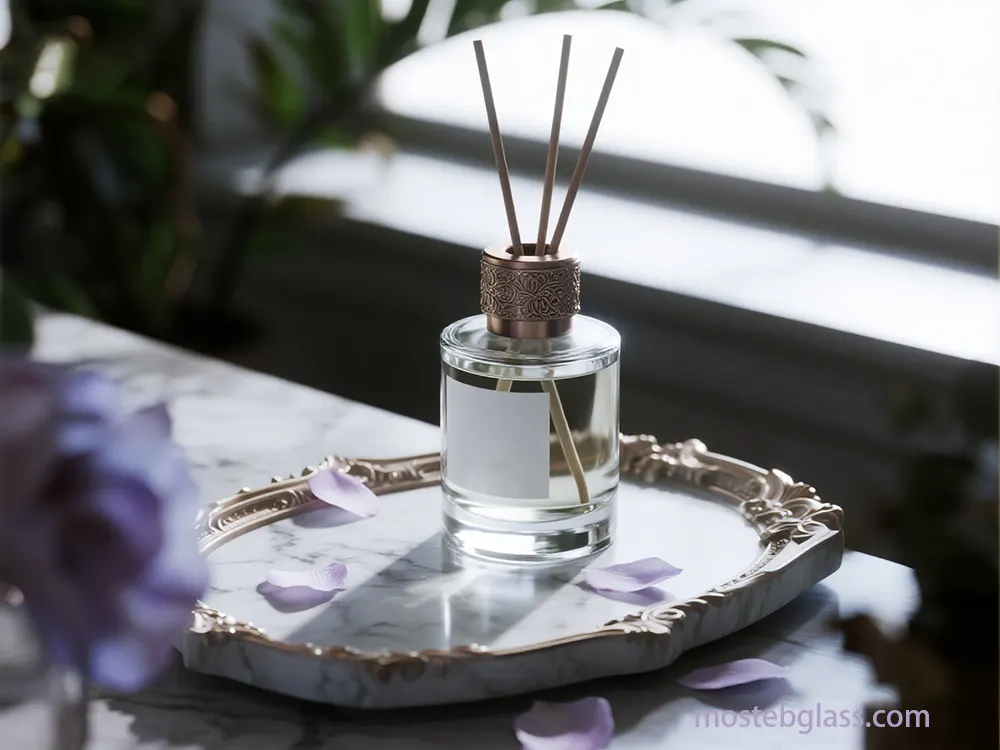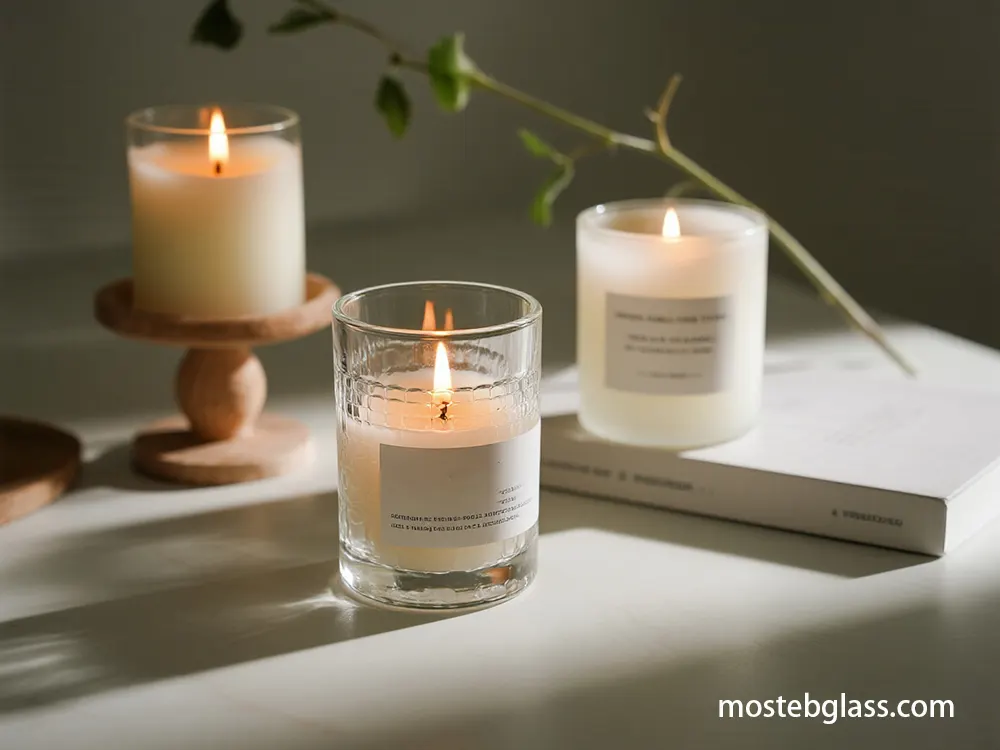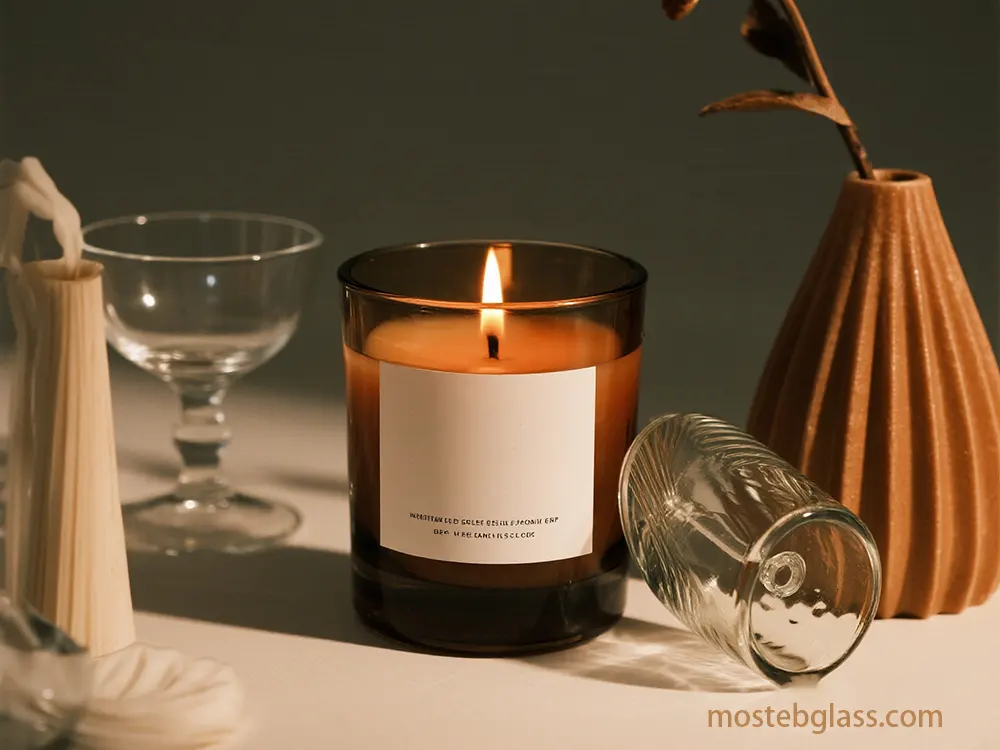2.1. Lựa chọn Vật liệu
Lựa chọn vật liệu ảnh hưởng sâu sắc đến tác động giác quan, độ bền và quan niệm thương hiệu.
Kính:
Phổ biến và linh hoạt, chai thủy tinh trình bày ánh sáng và màu sắc của đèn, dễ dàng nhãn hiệu hóa.Tùy chọn bao gồm soda-lime, borosilicate (cho nhiệt độ cao) và kính tái chế cho tính bền vững.
Chai đất sét tự nhiên truyền tải cảm giác cao cấp, thủ công, làm thủ công. Bền, chúng giữ nhiệt cho đốt ổn định và có thể tái sử dụng, phù hợp với tính bền vững.
Kim loại:
- Nhẹ, bền và tương đối có thể tái chế, hộp kim loại (nhôm, mạ kẽm) cung cấp thẩm mỹ hiện đại, tối giản hoặc công nghiệp, đặc biệt phù hợp cho đèn du lịch hoặc điểm nóng cao do khả năng dẫn nhiệt. Rừng, phân hủy nhanh, tre mang đến cảm giác nông thôn, tự nhiên, kết hợp tốt với sáp xanh.
- Gốm sứ: Chai phân hủy sinh học từ sáp đậu nành, lanh hoặc tinh bột ngô cung cấp một giải pháp tự nhiên, hoàn toàn.
- Giấy tái chế và xốp tạo ra các lựa chọn nhẹ, phân hủy sinh học, bền vững. Chai làm từ các nguồn tài nguyên tái tạo như ngô hoặc đường mía.
- Tre: Vật liệu tự nhiên, không độc hại, hoàn toàn cơ bản tạo ra các chai kiểu bê tông hiện đại.Cần đóng kín đúng cách.
- Vỏ dừa: Hình dạng tùy chỉnh và mẫu là yếu tố quyết định đối với các chai đèn cụ thể.
- Các vật liệu gốc thực vật: Hình dạng chai thủy tinh phức tạp đòi hỏi công nghệ làm mẫu hiện đại, bao gồm mô hình 3D, gia công CNC và hoàn thiện.Lost wax casting và các mẫu đất sét chuyên dụng phù hợp cho sản xuất lô nhỏ.
- Giấy bìa và bột giấy: Ảnh hưởng trực tiếp đến độ tròn, mịn và độ bền của chai, với các chất lượng kém gây ra lỗi. Các yếu tố hợp kim (ví dụ: đồng, crom) cải thiện độ bền và tuổi thọ của mẫu đúc gang.
- Biplastics: Bị ảnh hưởng bởi việc đặt sai vị trí của tấm kính rời, vết cắt do dao, vật liệu mẫu/không khí kém và thiết kế ban đầu sai lầm.
- Mẫu DIY và Lô nhỏ: Các hoạt động nhỏ hơn có thể sử dụng vật liệu tái chế (chai thủy tinh, giấy bìa cứng, nhựa).Mẫu silicone (keo silicone, bột ngô) tiết kiệm chi phí, linh hoạt, bền và không dính. ComposiMold cung cấp khả năng tái sử dụng.
2.3. Surface Finishes
Surface finishes decorate tactile and visual enchantment, influencing perceived luxurious and best.
- Frosting: Muted translucency, diffusing mild for an elegant appearance.
- Etching: Inscribes problematic styles, designs, and emblems for classy, enduring branding.
- Metallization: Thin metal coating for top class, reflective, or matte finishes. Color Coatings:
- Wide spectrum of colors, from pastels to jewel tones, developing ambiance.Water-primarily based lacquer varnish affords gloss and safety. Tactile Elements:
Soft-touch matte finishes or linen textures beautify sensory experience, conveying high-priced.Smoothness suggests high great.
Visual Design:
- Colors and graphics make a contribution to perception; e.G., earth tones for natural candles, vibrant shades for energetic scents.White space enhances perceived luxurious. 2.4. Integrated Labeling Techniques
- Labeling is integral to branding and can be seamlessly integrated into the jar’s design. Direct Printing:
Digital printing applies specialized ceramic ink directly onto the jar, permanently fused during tempering or firing.This creates durable, scratch-resistant designs with intricate details, wider color range (full-color, gradients, photographic images), and flexibility.Inkcups and Vibrantz Technologies offer relevant solutions. - Decals: Pre-published designs or emblems carried out as decals, frequently fired for permanence.
- Embossing/Debossing: Creates raised or recessed designs on glass for a sophisticated tactile, three-D branding effect.
- High-Quality Labels: Custom adhesive labels with embossed designs, minimalist typography, and steel foil accents enhance perceived steeply-priced.
2.5. Bespoke Secondary Packaging
Secondary packaging complements the unboxing experience and reinforces emblem messaging.
- Material Choice: High-end rigid cardboard conveys luxurious; sustainable kraft paper shows eco-focus.
- Visual and Tactile Elements: Window reduce-outs, layered textures, or steel finishes create anticipation.
- Unboxing Experience: Thiết kế cẩn thận trong việc mở hộp ảnh hưởng đáng kể đến kết nối cảm xúc và giá trị cảm nhận, có khả năng nâng cao chi phí sản phẩm cảm nhận lên đến 45%.
- Các khía cạnh chức năng: Độ bền cơ cấu bảo vệ cây nến trong quá trình vận chuyển. Các tính năng như lõi gối foam tùy chỉnh, vách đôi hoặc lớp phủ UV giúp tăng độ bền.
3. Công nghệ sản xuất tiên tiến cho phép tùy chỉnh
Tùy chỉnh tinh vi, lấp lánh và hiệu quả về giá được thúc đẩy bởi sự phát triển nhanh chóng của công nghệ sản xuất, cung cấp sự tự do lớn hơn về thiết kế, độ chính xác và hiệu suất.
- 3.1. Công nghệ tạo khuôn tiên tiến Công nghệ tạo khuôn hiện đại tận dụng các phương pháp tiên tiến nhất cho các tấm kính phức tạp, độc đáo và có thể lặp lại.
- Hoàn thiện máy CNC chính xác: Tạo ra các khuôn tương đối chính xác và có thể lặp lại với chi tiết tinh vi, quan trọng cho các hình dạng cụ thể và chất lượng nhất quán.
- Vật liệu và lớp phủ khuôn chuyên dụng: Các hợp kim luyện sắt tiên tiến với thành phần (ví dụ: đồng, crôm) tăng cường khả năng chống mài mòn và chống oxy hóa, kéo dài tuổi thọ và giảm lỗi. Các lớp phủ chống ăn mòn cũng tăng thêm tuổi thọ khuôn.
- In mẫu nhanh cho khuôn: In 3D cung cấp vòng lặp thiết kế nhanh chóng, tiết kiệm chi phí cho khuôn (ví dụ: silicone, Jesmonite) trước khi sản xuất kính quy mô đầy đủ.

3.2. In ấn số
In ấn số đã cách mạng hóa việc trang trí bề mặt kính, cung cấp sự linh hoạt, chi tiết và sao chép màu sắc chưa từng có.
In trực tiếp lên kính bằng in ấn số:
Áp dụng mực sứ chuyên dụng trực tiếp lên kính, hoàn toàn kết hợp trong quá trình xử lý nhiệt độ cao hoặc nung. Điều này tạo ra các thiết kế bền bỉ, chống mài mòn, có thể chống chịu UV, hóa chất và mài mòn.
- Độ phân giải cao và gam màu rộng: Cung cấp chi tiết tinh vi, gam màu rộng hơn và sự linh hoạt hơn so với in ấn màn hình lụa, cho phép in toàn màu, gradient và hình ảnh chân thực. Vibrantz Technologies cung cấp mực phù hợp.
- Hiệu quả và tùy chỉnh: Tối ưu hóa sản xuất để rút ngắn thời gian hoàn thành. Cho phép in ấn giá rẻ cho các thiết kế độc nhất, lô nhỏ và tùy chỉnh cao, làm cho bao bì tùy chỉnh trở nên dễ dàng.
- Công nghệ xử lý: Các máy in hiện đại sử dụng công nghệ vận chuyển mực tiên tiến và xử lý UV xanh lá cây tiên tiến để khô nhanh hơn, giảm độ cứng và tương thích mực tốt hơn.
Nhà sản xuất thiết bị:
Inkcups (Helix®, Double Helix®) và Xaar heads là những người chơi chính.
- 3.3. Khuôn khắc laser Khuôn khắc laser cung cấp một phương pháp chính xác, tinh tế để thêm các thiết kế phức tạp, logo hoặc văn bản lên bề mặt kính. Quy trình không tiếp xúc này sử dụng một laser tập trung để bào mòn hoặc xốp bề mặt, tạo ra chi tiết tinh vi và hoàn thiện cao cấp, vĩnh viễn, truyền tải sự sang trọng tinh tế.
- 3.4. Ứng dụng lớp phủ chuyên dụng Các lớp phủ chuyên dụng làm đẹp mọi khía cạnh thẩm mỹ và tính năng thực tế của lọ cây nến.
- Lớp phủ UV: Enhance sturdiness, scratch resistance, and UV safety.
- Soft-Touch Coatings: Create a expensive, velvety tactile sense, improving unboxing and perceived value.
- Anti-Slip Coatings: Improve grip and protection, mainly for large jars.
Functional Inks:
Can impart homes like electric conductivity or energy efficiency for advanced glass packages.
3.5. The Potential Future Role of Additive Manufacturing (3D Printing)
Additive production (3-d printing), specially for glass, is an rising technology with substantial capability for prototyping and area of interest production of candle jars, imparting ultimate customization and design freedom for manufacturers like Mosteb.
- Technological Advancements: Include Direct Glass Laser Deposition (Nobula3D), low-temperature methods (MIT), Microscale Computed Axial Lithography (UC Berkeley), Glassomer Technology (LGM), Two-Photon Polymerization (UC Irvine), and fabric extrusion/direct ink writing.
- Design Freedoms: Creates complex shapes, tricky textures, and inner systems difficult or high-priced with conventional techniques, allowing precise designs.
- Prototyping and Niche Production: Promising for fast prototyping and small, exceedingly customized batches or excessive-cost area of interest merchandise in which exclusivity is prime.
- Glass-crammed polymers decorate properties.Recycled glass can be used as feedstock, selling circularity. Environmental Benefits:
Reduces material waste.Using recycled glass/geopolymers can cut CO2 emissions by way of up to 70%.
Challenges:
- May lack very excessive resolution.High-resolution business printers are high-priced, and material fees range, with better resolution growing print time/price. 4. Customization Strategies for Brand Differentiation Across Market Segments
- Different candle marketplace segments leverage customization to reap awesome emblem identities, enhance perceived price, and benefit competitive blessings, relying on course consumers, logo positioning, and production skills. 4.1. Luxury Market Segment
- Luxury producers prioritize exclusivity, craftsmanship, and an increased, multi-sensory enjoy. Materials:
- Sự tương thích vật liệu: Shapes and Textures:
- Unique and uncommon shapes (geometric, asymmetric) and reflective textures (frosted, embossed) upload special sensory entertainment. Finishes and Colors:
- A range of conventional hues (gold, silver, black, white) in steel, remarkable-gloss, or matte finishes offers a pleasant finished appearance. Frosted glass is a sophisticated splendor. Integrated Branding:
Custom labeling talents fashionable embossed designs, minimalist typography, and steel foil accents, reinforcing popularity and exclusivity.
Meticulously designed secondary packaging (high-end inflexible cardboard, layered textures, defensive inserts) for a memorable unboxing, contributing to perceived price.
Sustainability in Luxury:
Growing prioritization consists of reusable alternatives and sustainable substances, exemplified via Dior’s recognition on refillable luxurious.
- 4.2. Mass-Market Segment Mass-market brands focus on broad appeal, cost-effectiveness, and efficient production while differentiating.
- Standardized Customization:Uses standard jar shapes, customized via economical methods like vibrant color coatings, direct printing, or decals.
- Material Efficiency: Primarily glass, but may use more economical glass types or lightweight metal tins for specific lines (e.g., travel candles).
- Efficient Labeling: Digital printing offers cost-effective solutions for large runs, providing design flexibility without substantial cost escalation.
- Vật liệu và lớp phủ khuôn chuyên dụng: Meets high MOQs for lower per-unit costs, requiring careful inventory management to avoid overstocking.
- 4.3. Artisanal and Small Business Segment Artisanal manufacturers emphasize uniqueness, hand made enchantment, and sustainability.
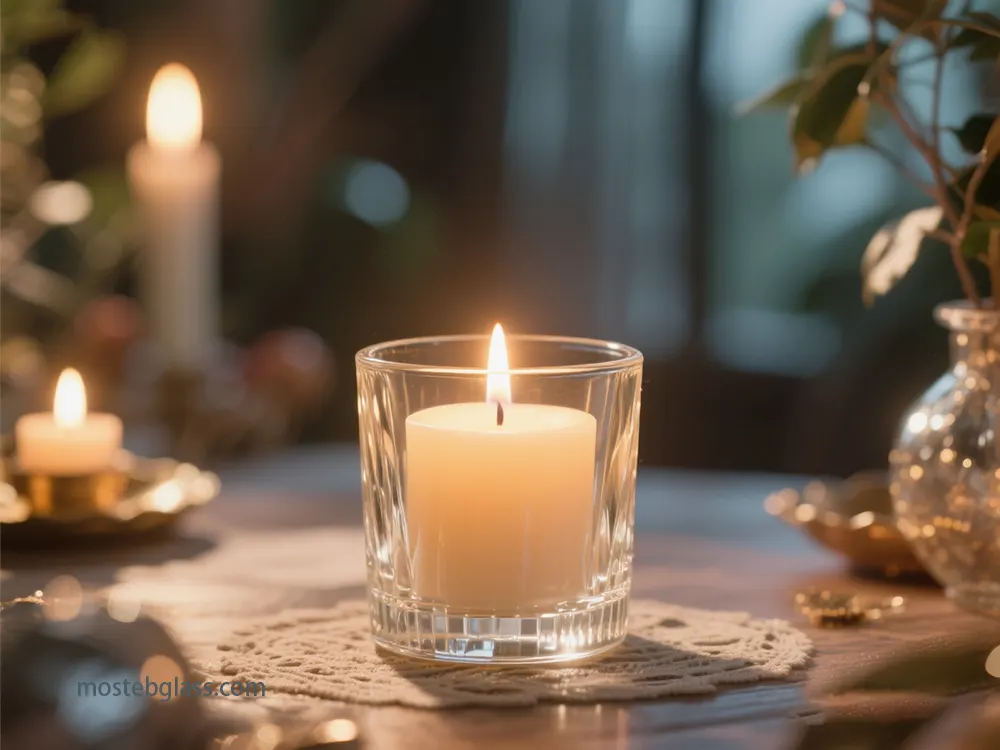
Flexible Customization:
Faces demanding situations with excessive MOQs (10,000-50,000 devices) and great upfront mould fees ($50,000-$a hundred,000) from custom glass producers.
- Solutions for MOQs: Partnering with specialized quick-run producers,collaborative purchasing,3-D printing for prototyping/niche designs,the usage of popular jars with custom labels,negotiation for flexible terms, and capacity modular layout strategies.
- Material Focus: Strong desire for green substances like recycled glass,artisanal ceramic, aluminum, bamboo, or upcycled coconut shells. Reusability and refillability are key.
- Authenticity: Designs often incorporate natural, earthy elements, complementing natural waxes and fragrances, sometimes with sustainable wooden wicks.
- 4.4. Eco-Friendly Segment This section prioritizes minimizing environmental effect throughout the product lifecycle.
Sustainable Materials:
Heavy reliance on materials with reduced environmental footprint: recycled glass ,ceramic, aluminum, bamboo, upcycled coconut shells, and plant-based bioplastics.
- Refillable Designs: Crafted for long-term, repeated use with wax refills, minimizing unmarried-use waste and selling a circular economic system.
- Production Processes: Emphasis on processes minimizing environmental harm, including low energy consumption (e.g., cullets in glass production), waterless dyeing, and efficient wax consumption.
- End-of-Life Considerations: Focus on responsible disposal: jar return programs,biodegradable coatings, and encouraging upcycling.
- Brands seek certifications like FSC, Cradle to Cradle Certified®, Green Seal, ISO 14001, EcoVadis, and B Corp to validate sustainability claims. Lifecycle Assessment (LCA):
Critical device to research environmental effect from raw material extraction to disposal, that specialize in reducing carbon footprint, waste, and emissions.
Mosteb can strategically function itself by way of leveraging advanced virtual printing for mass-market enchantment, exploring glass 3-d printing for special luxury collections, and prioritizing recycled substances and refillable designs for eco-conscious traces.
- 5. Quantifying Brand Differentiation Achieved Through Jar Customization Measuring the impact of customized candle jars requires a robust framework of methodologies and KPIs to assess ROI and optimize market position.
- 5.1. Defining and Calculating Packaging ROI Packaging ROI represents the financial return from strategic investments in packaging design,encompassing sales increases, customer satisfaction, loyalty, and profitability.
- A high ROI indicates effective revenue generation relative to packaging expenditure. 5.2. Key Performance Indicators (KPIs) for Packaging Differentiation
- Evaluating packaging ROI involves analyzing its impact across sales, cost efficiency, brand perception, and operational effectiveness. 5.2.1. Sales and Market Performance Metrics
- Chứng nhận: Tracking sales and revenue before and after packaging changes.
- Market Share Shifts: Monitoring changes to determine if packaging helps capture larger market share.
Premium Pricing Power:
Assessing ability to command higher prices for customized products, indicating enhanced perceived value.
Product Turnover Rate:
Measures how frequently products are sold, indicating consumer demand.
Customer Acquisition Cost (CAC):
Analyzing if differentiated packaging reduces new customer acquisition costs.
5.2.2. Cost Efficiency Metrics
Cost Per Unit (CPU):
Total cost of packaging each unit (materials, labor, overhead).
- Hiệu quả về chi phí: Tiết kiệm từ các giải pháp đóng gói hiệu quả. Theo dõi chất thải vật liệu trong quá trình sản xuất.
- Hiệu quả hoạt động: Tác động của thiết kế đóng gói đến logistics, xử lý, lưu kho và giảm hàng hỏng.
- Thời gian chu trình sản xuất: Thời gian từ đơn hàng đến giao hàng, xác định cơ hội giảm thời gian chờ.
- Tỷ lệ sử dụng máy móc: Đánh giá hiệu suất thiết bị và tối thiểu hóa thời gian ngừng hoạt động.
- Tỷ lệ lưu chuyển hàng tồn kho: Duy trì mức tồn kho hiệu quả và tối ưu hóa hiệu quả đóng gói.
5.2.3. Mức độ nhận thức thương hiệu và chỉ số tương tác khách hàng
- Điểm đánh giá phản hồi/khách hàng (CSS): Phản hồi trực tiếp về bố cục đóng gói, thẩm mỹ và chức năng.
- Chỉ số người đề xuất (NPS): Đo lường lòng trung thành của người mua và ý muốn đề xuất, được truyền cảm hứng qua đóng gói.
- Khả năng hiển thị thương hiệu và sức hấp dẫn kệ hàng: Đánh giá mức độ đóng gói nổi bật; nghiên cứu theo dõi ánh mắt đo lường tác động hiển thị.
- Tương tác trực tuyến: Theo dõi đề cập trên mạng xã hội, đánh giá và video mở hộp liên quan đến đóng gói.
- Tỷ lệ giữ chân khách hàng và tần suất đặt hàng lặp lại: Theo dõi xem đóng gói khác biệt có tăng giữ chân và mua hàng lặp lại hay không.
- Trình bày sản phẩm: Mức độ hiệu quả của đóng gói trong việc trình bày sản phẩm và phù hợp với hình ảnh thương hiệu.
5.2.4. Chỉ số bền vững
- Chỉ số bền vững: Chỉ số tổng hợp phản ánh tác động môi trường của vật liệu và kỹ thuật đóng gói.
- Đánh giá vòng đời (LCA): Đánh giá tác động môi trường toàn diện từ đầu đến cuối (dấu chân carbon, điện năng, kết thúc cuộc đời).
- Tìm nguồn vật liệu: Theo dõi tỷ lệ vật liệu tái chế, tái tạo hoặc có nguồn gốc bền vững.
- Waste Generation and Recycling Rates: Analyzing packaging waste and recyclability rates.
- 5.3. Methodologies for Measurement A/B Testing:
- Evaluates customer sentiment by way of imparting special layout versions to distinct target market segments, isolating variables to degree overall performance. Consumer Research:
Qualitative/quantitative techniques (surveys, cognizance agencies) to recognize patron perceptions, preferences, and emotional responses to packaging.
- Market Testing: Compares real-international overall performance of different packaging designs in managed or stay market situations.
- Blind Tests: Presents programs with out brand statistics to gauge impartial choice.
- Eye-Tracking Studies: Neuro-advertising strategies to evaluate shelf impact and logo popularity by way of monitoring gaze patterns.
- Packaging Audit: Systematic analysis of packaging components and tactics to discover upgrades in efficiency, price-effectiveness, and sustainability.
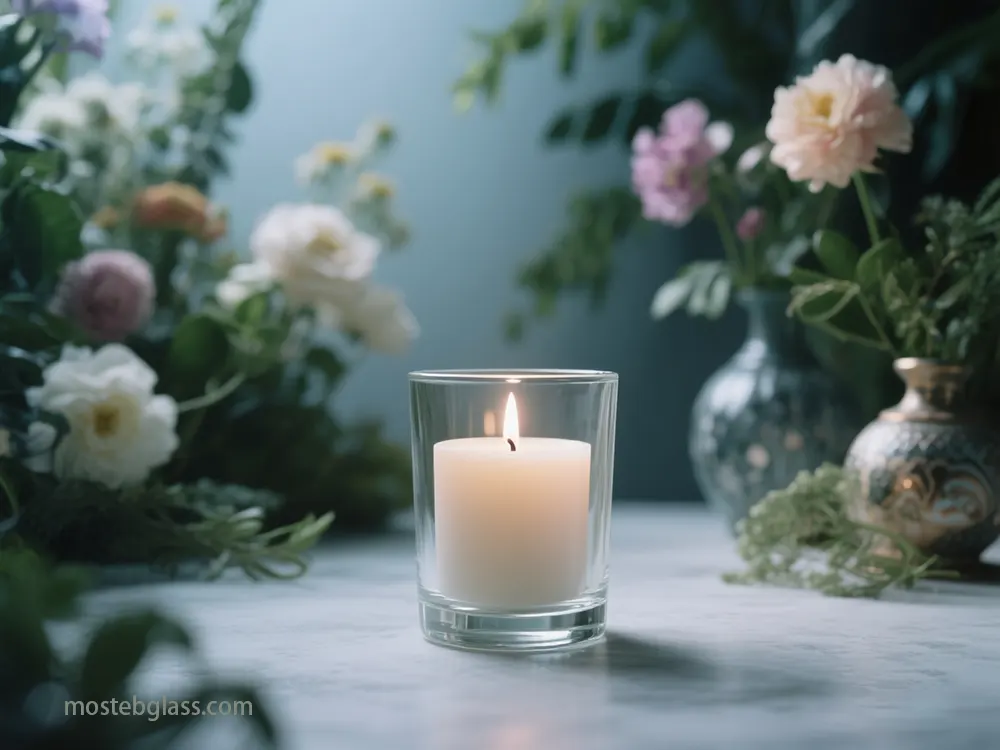
Data-Driven Decision Making:
- Continuously analyzes packaging overall performance metrics, which includes unboxing delight, return prices, and purchaser comments. Analytical Techniques:
- High-decision mass spectrometry for cloth high-quality, safety, and compliance. For Mosteb, integrating those KPIs and methodologies into a non-stop remarks loop is crucial for agile modifications, ensuring customization interprets into measurable logo differentiation, loyalty, and ROI.
- 6. Geographic Market Nuances and Consumer Perception of Customization Consumer notion of customization varies significantly throughout geographic markets, encouraged by means of regional alternatives, cultural contexts, and numerous expectations. Understanding these nuances is vital for Mosteb and other brands aiming for global resonance.
- 6.1. Regional Preferences and Aesthetic Trends Minimalist aesthetics:
- Simple strains, simple shapes, and neutral hues have become increasingly more famous global, mainly in markets within the West and urban facilities. Eco-pleasant substances:
- Our global markets (generally in Europe and North America) show off a growing call for for recycled glass, metallic, or biodegradable materials; reusability and refillability are important. Retro-inspired designs:
- Popular with clients searching for nostalgia and craftsmanship in markets with wealthy conventional histories, patterned glass, complicated designs, and traditional shapes are coming returned into fashion. Natural and Earthy Elements:
- Designs incorporating timber, stone, or terracotta benefit reputation, complementing natural waxes and fragrances, resonating in well being-targeted markets. Translucent and Colored Glass:
Creates warm ambiance when lit. Trends encompass tender pastels and vibrant jewel tones, popular for seasonal customization.
Material Preferences thru Region:
Glass jars are commonly desired globally.Ceramic jars provide a hand made aesthetic.Metal jars offer a cutting-edge-day, minimalist, or industrial aesthetic, appropriate for excursion.
Luxury Aesthetics:
- High-exquisite materials (thick glass, satisfactory porcelain), conventional colours (gold, silver, black, white), ultra-present day steel/matte finishes, and specific shapes universally imply high-priced, even though cultural interpretation varies. 6.2. Cultural Contexts and Consumer Expectations
- Cultural Symbolism: Specific colors, shapes, or motifs deliver profound cultural that means; customization incorporating those factors fosters authenticity and deep connection.
- Gifting Culture: In regions with strong gifting traditions, packaging emphasizing presentation, unboxing, and perceived fee is pretty effective.
- Sustainability Consciousness: Varies by using manner of region; European markets often have better expectancies and stricter rules.
- Brand Storytelling: Consumers reply in a special manner to logo narratives (ancient beyond vs. Innovation); customization lets in tailoring storytelling.
- 6.3. Impact of E-commerce The rise of e-trade amplifies packaging’s significance as a brand touchpoint. For online income, the unboxing revel in replaces in-keep interaction,necessitating great visual attraction in product photography, defensive and aesthetic internal packaging, and a meticulously orchestrated product screen. Packaging must additionally face up to transport rigors even as conveying luxury.
- 6.4. Regional Market Growth in Manufacturing Technologies Adoption of superior manufacturing technology varies regionally. Europe and North America preserve the most important market share for digital glass printing, while Asia, in particular China, indicates rapid boom,influencing supply chain choices for worldwide brands.
For Mosteb, a nuanced knowledge of those geographic variations permits for centered, culturally sensitive, and effective customization techniques, ensuring cultural resonance and assembly neighborhood consumer expectancies for aesthetics, capability, and sustainability.
- 7. Challenges and Future Outlook in Custom Candle Jar Manufacturing While customization offers vast possibilities, its implementation faces challenges. Understanding those hurdles and anticipating destiny trends is crucial for both candle brands and candle jar manufacturers like Mosteb to thrive.
- 7.1. Key Challenges in Implementing Advanced Customization Cost Implications:
- High prematurely mold fees ($50,000-$100,000+) are a major barrier for SMBs.Customization, specially for smaller runs, ends in higher in line with-unit costs because of fixed prices spread over fewer units.Inefficient production for complex orders can boom material waste. Extended Lead Times:
- Custom mold creation is lengthy (12-sixteen weeks).Intricate designs and specialised finishes necessitate multi-stage approaches, extending timelines and impacting marketplace responsiveness. Minimum Order Quantities (MOQs):
Glass manufacturers impose high MOQs (10,000-50,000+ devices) for custom-molded jars to amortize charges.Customization provides complexity to standardized manufacturing, doubtlessly leading to inconsistencies and slower deliveries.Larger volumes mitigate risks until manufacturing strains are subtle.
Scalability Issues:
Manufacturers specializing in especially customized or small-batch manufacturing might also have constrained capacity, difficult rapid scaling. Maintaining consistent quality from small to large runs is a sizable assignment.
Inventory Management and Cash Flow Strain:
High MOQs can lead to overstocking, growing protecting costs and tying up capital.
Demand Prediction Challenges:
The bespoke nature of custom orders makes predicting call for tough, growing risk of overproduction or stockouts.
Advancements in Additive Manufacturing (3-d Printing):
- Glass 3-D printing (e.G., DGLD by way of Nobula3D, MIT’s low-temperature techniques) is becoming greater feasible, promising rapid prototyping, complicated geometries, and cost-effective small-batch production.3-D printed molds (silicone, Jesmonite) offer flexibility for rapid layout new release and small-scale manufacturing. Digitalization in Manufacturing:
- Industry four.0 integration (IoT, AI, ML) transforms glass manufacturing for greater performance, flexibility, and actual-time optimization.Digital twins and plant-huge automation similarly enhance workflows and satisfactory. Sustainable Customization Practices:
- Focus on spherical monetary machine models (reuse, recycling, composting, refillable designs).R&D into revolutionary sustainable substances (plant-based, bioplastics, recycled content material fabric). Growing significance of eco-certifications (FSC, Cradle to Cradle, Green Seal, B Corp).Prioritization of decreased environmental footprint in procedures (energy, water, carbon emissions). Hybrid Manufacturing Approaches:
- Future production will probable integrate additive and conventional strategies, optimizing design freedom and performance. Personalization at Scale: Advancements in virtual printing will allow incredibly customized candle jars (character names, messages, bespoke designs), growing unprecedented customer engagement.
- For Mosteb, embracing those rising technologies and sustainable practices is fundamental to preserving competitive aspect. Strategic investments in glass 3-d printing R&D, partnerships with quick-run manufacturers, and prioritizing eco-friendly substances will function Mosteb as a visionary chief. 8. Conclusion and Strategic Recommendations
- Customization in candle jar production is critical for brand differentiation. The candle jar acts as a powerful brand ambassador, influencing perception, cost, and shopping choices. Every measurement of customization—materials, finishes, shapes, labeling—contributes to a awesome emblem identification. Advanced production technologies, particularly virtual printing and glass 3-d printing, continuously make bigger opportunities for complex, high-quality, and cost-effective customization, empowering manufacturers like Mosteb. However, advanced customization faces demanding situations: massive upfront mold costs, extended lead instances, and high MOQs, disproportionately affecting smaller brands. Navigating those complexities calls for meticulous making plans, innovative partnerships, and investment in rising technology.
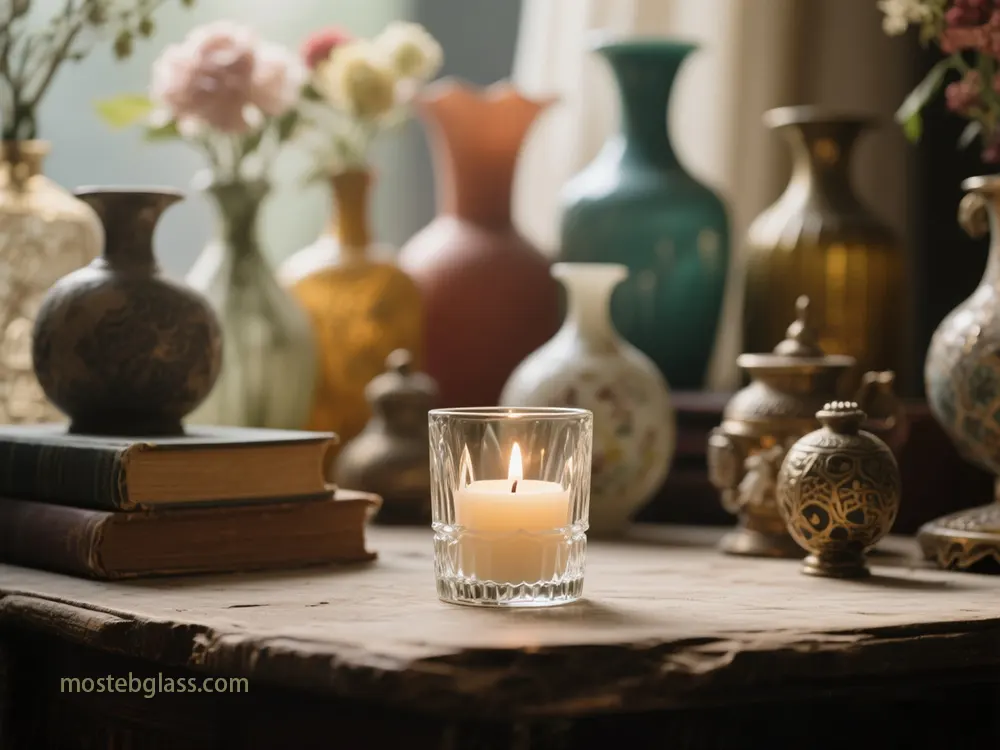
8.1. Strategic Recommendations for Candle Brands
Define Differentiation Strategy:
- Clearly articulate your logo’s particular value proposition (luxury, sustainability, artisanal, mass-market) to manual cloth, format, and production companion selections. Invest in Design and Multi-Sensory Experience:
- Prioritize captivating aesthetics, tactile factors (smooth-touch finishes, etched glass), and the general unboxing adventure, thinking about interaction with fragrance and burn average overall performance. Leverage Digital Printing for Agility:
- Embrace direct-to-glass virtual printing for problematic details, vibrant complete-colour pictures, and quicker turnaround, providing flexibility for seasonal/restrained variations and personalized runs. Proactively Address MOQ Challenges:
- Forge strategic partnerships for decrease MOQs; recollect collaborative sourcing; undertake modular design with custom finishes; make use of three-D printing for fast prototyping. Prioritize Sustainability:
Align customization with eco-friendly practices: opt for recycled substances, discover refillable designs, choose companions committed to strength-green, waste-lowering production, and speak transparently.
Understand Geographic Nuances:
Tailor customization to nearby possibilities and cultural contexts via marketplace studies, making sure relevance and recognition.
Quantify ROI:
Implement robust KPIs and methodologies (A/B testing, customer surveys, income facts, LCA) to measure tangible effect and economic go back, optimizing destiny investments.
8.2. Strategic Recommendations for Candle Jar Manufacturers
- Expand Customization Capabilities: Invest in superior production technologies: excessive-precision CNC mould making, cutting-edge digital printing (Inkcups Helix®), and complicated coating application structures.
- Innovate Mold Materials and Coatings: Dedicate R&D to new, excessive-overall performance mould materials and corrosion-resistant coatings to enhance mold lifespan, lessen defects, and beautify product pleasant.
- Develop Flexible Production Models: Cater to SMBs by means of exploring tiered MOQ systems, presenting devoted prototyping offerings, and investigating “glass on demand” or micro-manufacturing facility fashions for dynamic, price-green small-batch production.
- Invest in Glass 3-D Printing R&D: Invest in glass three-D printing research and development (e.G., Direct Glass Laser Deposition, Glassomer era), to advance, grow, and pilot glass three-D printing capabilities, that position Mosteb as a leader by offering great design freedom and fast prototyping.
- Embrace Industry 4.0 and Digitalization: Implement cutting-edge digital solutions (supply chain visibility, factory automation, digital twins) to improve workflows, shorten lead times, and maximize efficiency.
- Advocate Sustainable Manufacturing: Invest in methods that lessen environmental impact (reducing energy, water, carbon emissions) and receive environmental certifications (e.G., ISO 14001, EcoVadis) to showcase accountability.
- Offer Comprehensive Design and Consultation: Position Mosteb as a strategic associate via imparting expert steering on material desire, design feasibility, and value-powerful customization options.
8.2. Strategic Recommendations for Candle Jar Manufacturers
- Expand Customization Capabilities: Invest in superior production technologies: excessive-precision CNC mould making, cutting-edge digital printing (Inkcups Helix®), and complicated coating application structures.
- Innovate Mold Materials and Coatings: Dedicate R&D to new, excessive-overall performance mould materials and corrosion-resistant coatings to enhance mold lifespan, lessen defects, and beautify product pleasant.
- Develop Flexible Production Models: Cater to SMBs by means of exploring tiered MOQ systems, presenting devoted prototyping offerings, and investigating “glass on demand” or micro-manufacturing facility fashions for dynamic, price-green small-batch production.
- Invest in Glass 3-D Printing R&D: Invest in glass three-D printing research and development (e.G., Direct Glass Laser Deposition, Glassomer era), to advance, grow, and pilot glass three-D printing capabilities, that position Mosteb as a leader by offering great design freedom and fast prototyping.
- Embrace Industry 4.0 and Digitalization: Implement cutting-edge digital solutions (supply chain visibility, factory automation, digital twins) to improve workflows, shorten lead times, and maximize efficiency.
- Advocate Sustainable Manufacturing: Invest in methods that lessen environmental impact (reducing energy, water, carbon emissions) and receive environmental certifications (e.G., ISO 14001, EcoVadis) to showcase accountability.
- Offer Comprehensive Design and Consultation: Position Mosteb as a strategic associate via imparting expert steering on material desire, design feasibility, and value-powerful customization options.




